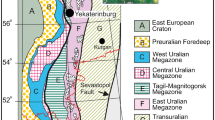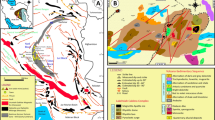Summary
¶Detailed petrographic studies and microchemical analyses of titanomagnetite from igneous and metamorphic rocks and ore deposits form the basis of this investigation. Its aim is to compare the data obtained and their interpretations with the experimentally deduced subsolidus oxidation-exsolution model of Buddington and Lindsley (1964). The results are also considered relevant for the interpretation of compositional variations in black sands which are recovered for titanium production. The arrangement of the samples investigated is in accordance with textural stages C1 to C5 caused by subsolidus exsolution with increasing degrees of oxidation (Haggerty, 1991).
Stage 1 is represented by two types of optically homogeneous TiO2-rich magnetite: a. An isotropic type considered to represent solid solutions of magnetite and ulvite containing between 5.2 to 27.5 wt% TiO2 corresponding to about 14.7 to 77.7 mol% Fe2TiO4 in solid solution with magnetite. The general formula of this type is Fe2+ 1+x Fe3+ 2−2x Ti x O4 (x = 0.0–1.0). b. The second type which has not been reported so far is anisotropic and shows complex internal twinning resembling inversion textures. It is thus attributed to inversion of a high-temperature ilmenite modification (with statistical distribution of the cations) which forms solid solutions with magnetite. TiO2 varies between 9.3 and 24.5 wt% corresponding to about 17.2 to 43.6 mol% ilmenite in solid solution with magnetite. This type is interpreted as a cation-deficient spinel with the general formula Fe2+ 12/12 + 1/4xFe3+ 24/12 − 3/2x □ 0 + 1/4x Ti x O4 (x = 0.0–16/12). Isotropic and anisotropic homogeneous magnetites occur in volcanic rocks only; the homogeneity of the solid solutions was explained by fast cooling which prevented the development of exsolution textures.
Stages 2 and 3 are represented by magnetite with or without ulvite. The magnetite host contains ilmenite lamellae forming trellis and sandwich textures. In contrast to the requirement of the oxidation-exsolution model, the ilmenite lamellae are concentrated exclusively in the cores of the host crystals. The reverse host-guest relationship may also occur. Stages 4 and 5 are identical with thermally generated martite (= martite due to heating). The textures are characterized by very broad lamellae of ferrian ilmenite or titanohematite dominantly concentrated along the margins of the host crystals. Thermally generated martite is restricted to subsolidus-oxidation reactions.
The ilmenite lamellae of trellis and sandwich textures contain low Fe2O3-concentrations (average 4.8 mol%; to a maximum of 8.3), whereas the Fe2O3-content of thermally generated martite is between 32 to 71 mol%. With respect to the Fe2O3-concentrations in the ilmenite lamellae, no transition between the two types was observed.
The results of this paper show that the widely accepted oxy-exsolution model of Buddington and Lindsley (1964) which is based on experimental results can – with the exception of thermally generated martite – not explain the tremendous variety of magnetite–ilmenite–ulvite relationships in natural rocks and ore deposits.
Similar content being viewed by others
Author information
Authors and Affiliations
Additional information
Received October 16, 2001; accepted May 2, 2002
Rights and permissions
About this article
Cite this article
Mücke, A. Magnetite, ilmenite and ulvite in rocks and ore deposits: petrography, microprobe analyses and genetic implications. Mineralogy and Petrology 77, 215–234 (2003). https://doi.org/10.1007/s00710-002-0216-1
Issue Date:
DOI: https://doi.org/10.1007/s00710-002-0216-1




